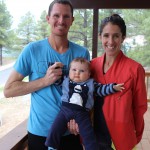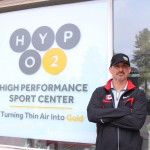- Slug: Sports-Olympics Flagstaff. 1,262 words.
- Photos available (thumbnails and captions below)
By KYLEE SAM
Cronkite News
FLAGSTAFF – Vince Sherry, a former collegiate cross-country runner at the University of North Carolina-Charlotte, visited Flagstaff for the first time in 2006. He liked it so much he moved there with his wife two weeks later.
Sherry isn’t the only runner to quickly fall victim to Flagstaff’s allure. He said it is unlike any other place to train. And Olympic hopefuls agree with him in growing numbers.
Flagstaff is situated about 7,000 feet above sea level and located 145 miles north of Phoenix, which is at 1,115 feet of elevation. Runners say it is in the “sweet spot” for altitude training with hundreds of miles of dirt roads and tree-lined, mountain terrain.
Add the almost near perfect summertime temperatures and countless views of the San Francisco Peaks, and Flagstaff is a distance runner’s paradise.
“I think Flagstaff sets itself apart from almost any place that you can train — at altitude specifically,’’ Sherry said. “The cost-benefit ratio is nearly ideal here in terms of the amount of benefit you get for the sacrifice you make in training.
“Any higher than this and most athletes tend to be a little too fatigued to put hard work in, and recovery time is lengthened. So it’s actually a disadvantage to train at a higher altitude. Much lower and you don’t necessarily get the altitude bump.”
Sherry is coach of Team Run Flagstaff (TRF), a local running team consisting of more than 400 runners of all ages and skill levels. The team includes TRF Kids, a program for youth up to 18 years old, and TRF Pro, the organization’s elite team of 14 national-class and world-class distance runners.
Nick Hilton, a former NCAA Division II collegiate runner turned professional, is the manager of Run Flagstaff and a member of TRF Pro. Originally from Reading, Pennsylvania, Hilton was researching running groups on the East Coast when his best friend from college convinced him to move to Flagstaff.
“In Reading, there’s not much of an elite scene or a lot of people at my level to train with, so I wanted to go somewhere,” he said. “In terms of location and training partners, Flagstaff was kind of unparalleled. So I decided to make the jump.”
Hilton moved to Flagstaff in 2012 and began training full-time with TRF Pro. He said he enjoys the laid-back Flagstaff lifestyle along with the benefits of the town’s ideal location.
“With Flagstaff being so uniquely located so close to lower altitude facilities like Sedona and Phoenix, it gives you the ability to be able to go down and train faster on the days you want to train faster while still being able to live and work at altitude,” Hilton said. “I’ve lived in a couple different places, and I’ve never been involved in a running community quite like Flagstaff because it’s so inclusive and welcoming.”
Sean Anthony, who is the CEO of HYPO2 High Performance Sport Center in Flagstaff, agrees with Hilton. HYPO2 began in 2008 as Northern Arizona University’s Center for High-Altitude Training, a former U.S. Olympic training site.
“One of the nice things about Flagstaff is you can be at an appropriate elevation for the desired physiological adaptations, but still get low enough to do some quality work,” Anthony said.
The elevation dips to 4,800 feet in Sedona, which is only an hour’s drive south from Flagstaff.
“Some of the teams go down to Sedona,” Anthony said. “And some of the running teams that are here right now are going to go down to Camp Verde to do some speed work down there so they can get a little higher quality work then they can get done at altitude.”
Anthony’s center helps elite domestic and international athletes with an array of altitude-based support services and training facilities.
“Our numbers now are close to 4,000 (athletes) from 27 different countries, and that’s just since 2008-09 when we started tracking,” Anthony said. “At NAU when we tracked, there are probably another 6,000. So it’s over 10,000 athletes at this point.”
As of early April, Anthony said there were close to 150 athletes from nine countries training at HYPO2 in Flagstaff.
Dan Bergland, a sport physiologist and owner of VOLT Sportlab at HYPO2, said the main reason people go to altitude is to increase their number of red blood cells, which enhances performance.
“The first thing that happens is you have a big erythropoietin (EPO) response,” Bergland said.
EPO is a hormone secreted by the kidneys that promotes the production of red blood cells. Altitude training causes EPO production to spike.
“With that EPO response, you have an increase in hemoglobin and an increase in red blood cells,” said Bergland, who also said that altitude training also causes an increase in capillaries, allowing more oxygen-delivering blood to reach the muscles.
Bergland said it takes four weeks of training at altitude for athletes to begin seeing benefits as their body adapts.
“At three weeks you see a substantial benefit, but between three and four weeks you get a big jump,” he said. “Beyond four weeks, there’s a diminishing return.”
Bergland said the optimal time for racing at lower altitude is three to four weeks after altitude training. After that, an athlete’s red blood cell volume begins to decrease.
“Also, in a running sense, (when) training at altitude then going back to sea level you become more economical, which means for the same amount of intensity and speed, you use less energy,” he said.
Ben Rosario is head coach and president of Hoka One One Northern Arizona Elite (NAZ Elite), a professional running team in Flagstaff whose mission is to recruit, develop and produce distance runners. He said there is another benefit that can’t be duplicated at sea level.
“Beside the physiological benefits, I think there’s also a mental component because it’s really hard to train up here,” Rosario said. “The workouts in Flagstaff are very difficult, and you have to be tough. So I think that side of it is almost as important.”
NAZ Elite is composed of 12 athletes. Two of them, Ben and Stephanie Bruce, are married.
Ben moved to Flagstaff from another running mecca, Eugene, Oregon, in 2011. Stephanie had already been in Flagstaff for more than a year.
Ben said there are similarities between the two popular training towns, but altitude is the difference.
“Eugene is ‘Track Town USA’ as they’ve dubbed themselves,” Bruce said. “But the benefit is that Flagstaff is at altitude. Some people think that’s better and some don’t. But I think the longer (the race), as you move up, the altitude becomes a little more important.”
The thin Flagstaff air is apparently paying dividends for him. In 2014, he entered five Rock ‘n’ Roll Marathon Series races and won all five of them, pulling off victories at 26.2 miles in New Orleans, San Diego, Montreal, St. Louis and Las Vegas.
“I think as long as my wife and I are running at a high level, we’ll be in Flagstaff,” he said. “I don’t know really where we’ll be after that, but we could finish running and just have fallen in love with Flagstaff so much that we want to stay.
“It really is one of the best places to train in the world as far as the altitude, the ability to get down to sea level, the ability to get to a major airport for travel’s sake,” Bruce said.“It’s a pretty awesome little niche.”


